|
As humans we are one of the most amazing and adaptive species on the planet. We adapt so well that this adaptation can sometimes have negative consequences, for example, adaptive poor posture, rounded shoulders, hunched spine etc. But, this adaptation can also happen in the opposite direction where we can make physical improvements over time by practicing good positions and adapting to productive stresses on the body. One of the most common elements that I see and have dealt with myself is shoulder injuries. This can vary far and wide in how symptoms manifest, but are often-times a result of a few common problems. These can often be improved with a few basic exercises. Over the years I have dealt with many of my own shoulder injuries including a rotator cuff and labrum repair about 15 years ago. Ever since then, I have had to put in extra time and focus on my shoulder to continue to allow for proper function mechanics. This includes mobility, stability and more but all starts with my go to shoulder warm up. I complete this before participating in any exercise or challenging life tasks. * Remember to always consult with your physician or physical therapist in regards to starting or changing your exercise routine and in no means is this information meant to diagnose or treat your injury. For full legal disclaimer, see About Me page. First start with good posture. (Click here to find out what good posture means if you are not sure.) With all the exercises that I will be sharing this is how to start the movement from this optimal posture position. 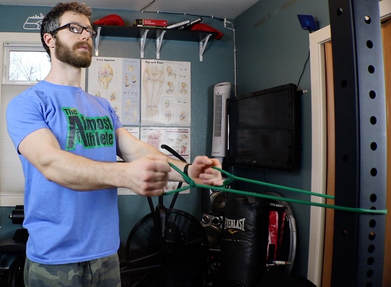 Standing Rows Starting Position Standing Rows Starting Position #1) Standing Rows Purpose This is a great exercise to help promote postural awareness as well as warm up your muscles including your rhomboids, middle traps, lower traps, deltoids, biceps and others.  Standing Rows Mid Point Position Standing Rows Mid Point Position How To Start by standing up tall with good posture. Wrap your resistance band around a post or or securing it in a door. Pull the band back with your arms by your side between your hips and your armpit by squeezing your shoulder blades together then slowly release your arms forward until your elbows are straight. Repeat this 10 times 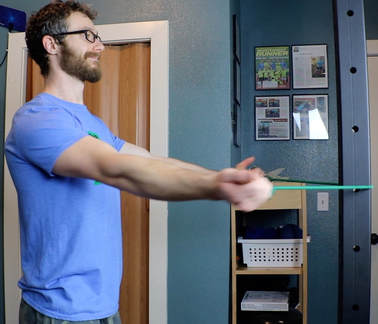 Shoulder Extensions Starting Position Shoulder Extensions Starting Position #2) Shoulder Extensions Purpose This exercise is important for continuing to warm up the muscles that surround the shoulder joint as well as to practice some mobility within the shoulder joint in a plane of motion that we often times neglect to utilize. When this becomes limited, this can lead to many shoulder problems including problems with the bicep tendon and rotator cuff muscles to name a few. 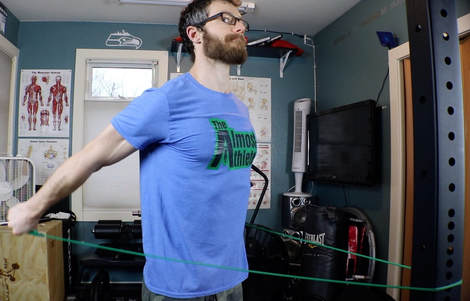 Shoulder Extensions Mid Point Position Shoulder Extensions Mid Point Position How To Again starting with good posture and the same resistance band. Straighten your arms so your elbows are extended and your hands are by your sides. Now pull your shoulder blades together and bring your arms behind you as far as you comfortably can, while trying to keep your shoulders down and back. Once you cannot go any further, slowly return of your starting position while maintaining the shoulder blade squeezed together as well as good posture throughout. Repeat this 10 times 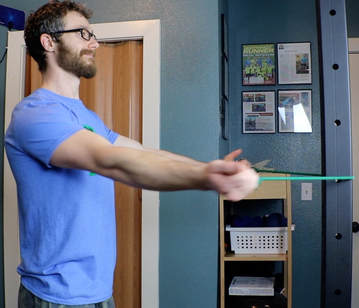 Standing T's (Horizontal Abduction) Starting Position Standing T's (Horizontal Abduction) Starting Position #3) Standing T’s (Shoulder Horizontal Abduction) Purpose Standing T’s help to activate and increase awareness of your shoulder stabilizers including your rotator cuff as well as your postural support muscles. Muscles being used include; infraspinatus, teres minor, mid traps, rhomboids, lower traps, posterior deltoid and others. This can also help to undo some of the excessive forward postures that we tend to adapt to during the work day. And finally, this can provide improved kinesthetic awareness of where your body is at in time and space which helps with posture.  Standing T's (Horizontal Abduction) Mid Point Position Standing T's (Horizontal Abduction) Mid Point Position How To Start by finding your good posture position with your core engaged. Next, raise both of your arms out in front of you with your elbows straight, then bring both arms out to your sides then back behind you, focusing on pinching your shoulder blades together to make this movement happen. Now, bring your arms out in front of you again. Repeat this 10 times.  Standing Y's (Shoulder Flexion) Starting Position Standing Y's (Shoulder Flexion) Starting Position #4) Standing Y’s (Shoulder Flexion) Purpose Standing Y’s help to activate and increase awareness of your shoulder stabilizers including your rotator cuff as well as your postural support muscles. Muscles being used include; infraspinatus, teres minor, mid traps, rhomboids, lower traps, posterior deltoid and others. This can also help to undo some of the excessive forward postures that we tend to adapt to during the work day. And finally, this can provide improved kinesthetic awareness of where your body is at in time and space which helps with posture. 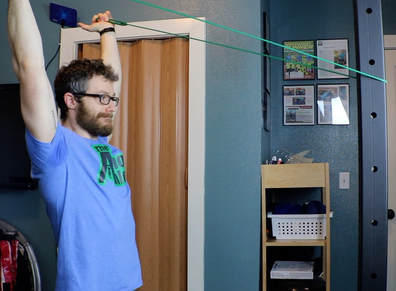 Standing Y's (Shoulder Flexion) Mid Point Position Standing Y's (Shoulder Flexion) Mid Point Position How To Start by finding your good posture position with your core engaged. Next, raise both of your arms out in front of you with your elbows straight and thumbs up, then bring both arms up towards your head, trying to get your arms just outside of your ears, focusing on bring your shoulder blades together and down to make this movement happen. Now, bring your arms back down in front of you again. This should look similar to the “touchdown” sign the referee's signal in football. Repeat this 10 times.  Shoulder External Rotation Starting Position Shoulder External Rotation Starting Position #5) Shoulder External Rotation Purpose This exercise specifically works on warming up your shoulders, deltoids and the rotator cuff muscles as well as continued postural awareness. 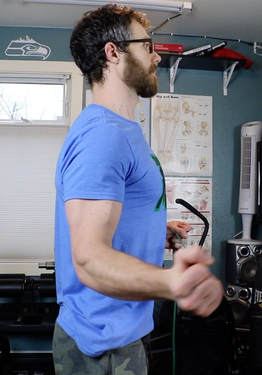 Shoulder External Rotation Mid Point Position Shoulder External Rotation Mid Point Position How To Starting with good posture. Again you’re going to grab the band in front of you with your left hand holding about halfway down the resistance band. With your right hand on one of the handles and maintaining good posture. With your elbow close to your side, you’re going to rotate your arm and externally (towards your right, away from your body). Once you have rotated us as far as you can comfortably without compromising your good posture, then slowly bring it back to your starting position. Repeat this 10 times. *Note some people have excessive shoulder range of motion and can rotate much further than necessary. If this is you, only rotate to about 45 to 75° and focus on maintaining good positioning.  Shoulder Blade Push Ups Stating Position Shoulder Blade Push Ups Stating Position #6) Shoulder blade push-ups at a desk or wall Purpose Shoulder Blade Push-Ups help to activate and increase awareness of your shoulder and scapular stabilizing muscles including your serratus anterior. These muscles tend to become under-developed and often times shut down on many of us and this problem becomes worse with poor posture. These muscles help to keep your shoulder blade in the proper position and assist with shoulder movements especially when lifting or reaching with our arms. Finally, this can provide improved kinesthetic awareness of where your body is at in time and space which helps with posture.  Shoulder Blade Push Ups Mid Way Position Shoulder Blade Push Ups Mid Way Position How To Start by finding your good posture position with your core engaged. Next, finding a clear spot on a wall or desk, and place your hands there about your shoulder width apart and just below shoulder height. Now, keep your elbows straight, pinch your shoulder blades together to bring your body slightly closer to the wall, then, spread your shoulder blades apart to push your body slightly farther away from the wall. You should be focusing on pinching your shoulder blades together then spreading them apart to make this movement happen. Remember this is a small movement where you don’t want to bend your elbows or round your back at all throughout this movement. Repeat this 10 times. Conclusion Although shoulder injuries, aches and pains are all too common, many can be improved or mitigated with some simple and consistent effort towards improving postural awareness as well as joint stability and mobility. And, although this is not a exhaustive list of all important shoulder exercises, this warm-up series has been a big help for me to maintain and improve with function of my shoulders.
1 Comment
9/6/2018 09:16:43 pm
Your shoulder warm up series were great! There are couples of reasons why some people have bad posture. Some claims say it is hereditary, but there are cases that say that it's acquired. It’s the way we live! If we think that our posture isn’t much of an issue, then you don’t know how important it is! That's why we should never disregard a simple pain because it could mean bigger health problem later on. I am glad to see you’re encouraging your followers to do what’s right!
Reply
Leave a Reply. |
Author : Jordan ProudfootHere are my thoughts and insights into fitness and wellness to be the best you possible. Archives
February 2019
Categories
All
|

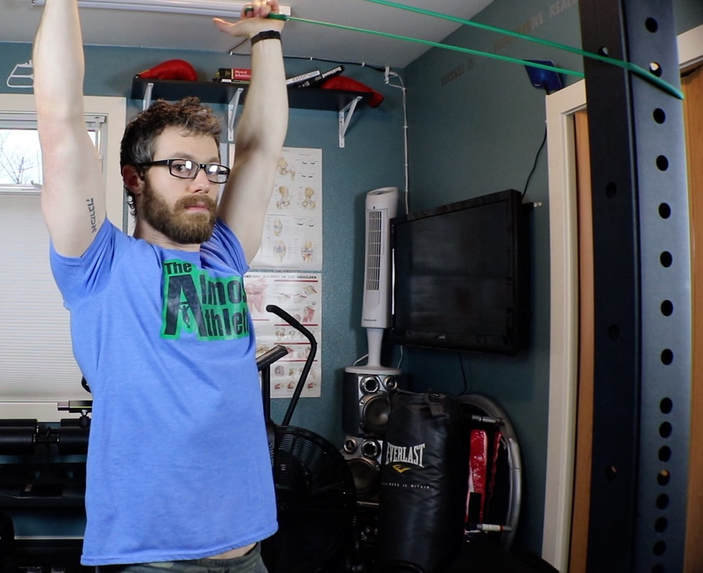
 RSS Feed
RSS Feed
